Olympus M.Zuiko Digital ED 9-18mm f/4-5.6 Review
Olympus M.Zuiko Digital ED 9-18mm f/4-5.6 Performance
At 9mm and maximum aperture, sharpness in the centre of the frame is already excellent and clarity towards the edges of the frame is very good. No real gains in clarity are to be had in the centre of the frame by stopping down at this focal length, but sharpness towards the edges of the frame improves to just below excellent levels with the aperture stopped down to between f/5.6 and f/8.At 14mm, the same high levels of sharpness are maintained in the centre of the frame at maximum aperture, but clarity towards the edges of the frame fall to fairly good levels. Stopping down to f/8 improves sharpness towards the edges of the frame to very good levels, whilst maintaining outstanding sharpness in the centre of the frame.
Finally, at 18mm, sharpness in the centre of the frame remains excellent at maximum aperture and just like at 14mm, clarity towards the edges of the frame falls behind somewhat, achieving fairly good levels. Stopping down to f/8 improves clarity towards the edges of the frame to good levels at this focal length.
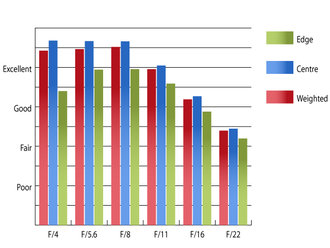 Resolution @ 9mm | 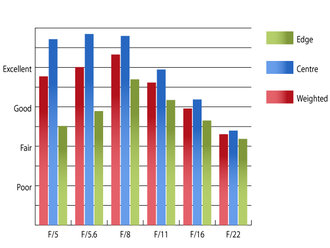 Resolution @ 14mm | |
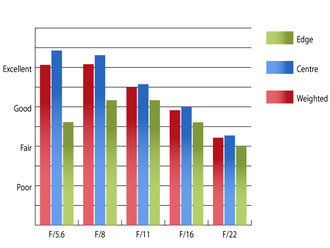 Resolution @ 18mm | How to read our chartsThe blue column represents readings from the centre of the picture frame at the various apertures and the green is from the edges. Averaging them out gives the red weighted column.The scale on the left side is an indication of actual image resolution. The taller the column, the better the lens performance. Simple. For this review, the lens was tested on a Panasonic Lumix DMC-G3 using Imatest. |
Chromatic aberrations towards the edges of the frame are well controlled at 9mm, but increase to noticeable levels with the lens zoomed beyond 14mm. Care may need to be taken when photographing scenes with high contrast edges places near the periphery of the image area.
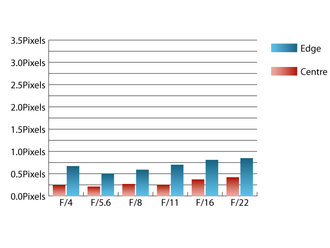 Chromatic aberration @ 9mm | 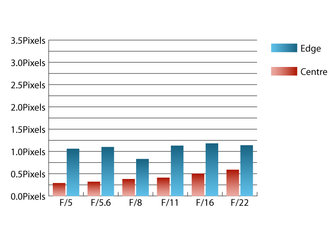 Chromatic aberration @ 14mm | |
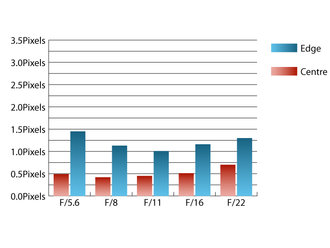 Chromatic aberration @ 18mm | How to read our chartsChromatic aberration is the lens' inability to focus on the sensor or film all colours of visible light at the same point. Severe chromatic aberration gives a noticeable fringing or a halo effect around sharp edges within the picture. It can be cured in software.Apochromatic lenses have special lens elements (aspheric, extra-low dispersion etc) to minimize the problem, hence they usually cost more. For this review, the lens was tested on a Panasonic Lumix DMC-G3 using Imatest. |
Falloff of illumination towards the corners of the frame is incredibly well controlled for a lens that covers such a wide field of view. At 9mm the corners are only 0.8 stops darker than the image centre and this decreases further to 0.45 stops with the lens zoomed to 18mm. Visually uniform illumination is achieved with the lens stopped down by one stop from the maximum aperture throughout the zoom range.
Distortion is also extremely well controlled throughout the zoom range with Imatest detecting only barrel distortion of 1.8% at 9mm and 0.1% at 18mm. This low level shouldn't pose many issues for normal day-to-day photography. If absolutely straight lines are paramount what little distortion there is should be relatively straightforward to correct as it is uniform across the frame.
No lens hood is supplied as standard with this lens and this lens is quite prone to flare and hazing with a bright light source in the frame. Although a hood for a lens covering such a wide angle-of-view would provide little protection against this, it still would've been good to have one included.
Add your message
Login required
Please login here or if you've not registered, you can register here. Registering is safe, quick and free.
Please login here or if you've not registered, you can register here. Registering is safe, quick and free.
photodo Stats
1102 lenses
428 MTF tests
74 in-depth photodo reviews
100+ users join each day
Help the lens community by reviewing or rating a lens today via our lens search
428 MTF tests
74 in-depth photodo reviews
100+ users join each day
Help the lens community by reviewing or rating a lens today via our lens search
Latest Lens Reviews
- Chinon 28mm f/2.8 Vintage Lens Review
- Canon EF 70-200mm f/4L IS II USM Lens Review
- Samyang AF 85mm f/1.4 EF Review
- Sigma 70mm f/2.8 DG Macro Art Review
- Samyang AF 24mm f/2.8 FE Review
- Meike 50mm f/1.7 Review
- Tamron 70-210mm f/4 Di VC USD Review
- Lensbaby Burnside 35mm f/2.8 Review
- Asahi Super Takumar 50mm f/1.4 Review
- Asahi Super-Multi-Coated Takumar 135mm f/3.5 Review
